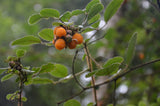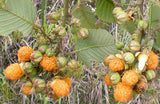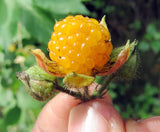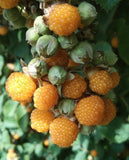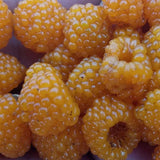Rubus ellipticus Seeds — Golden Echoes of Himalayan Wilds
Plant a golden treasure that weaves history, wildlife, and wild flavor into your garden tale. Rubus ellipticus, also known as Ainselu or Golden Himalayan Raspberry, offers luminous clusters of fruit, clusters of five-petaled blooms, and an evergreen presence from the foothills of the Himalayas.
Botanical Radiance & Bloom
-
Bloom Color: Spring unfurls clusters of small, white five-petaled blossoms, delicate beacons among downy, three-part leaves that soften the thorny silhouette.
-
Fruit Stage: Blooms transform into glowing, rounded golden-yellow raspberries, richly sweet yet fleeting—prized by birds, butterflies, and even elephants.
Hardiness & Growth Habit
-
USDA Hardiness Zones: Flourishes in Zones 7–10, adapting to sun, shade, moist soils, and even dense forest understories.
-
Growth Form: A robust, thorny evergreen shrub that can reach 4.5 m (15 ft) long—versatile, vigorous, and capable of forming dense thickets.
Wildlife & Ecological Harmony
-
Pollinator Magnet: While the flowers themselves spark interest from bees and butterflies, the fruit attracts frugivorous birds and wildlife, spreading the richness of your garden far and wide.
-
Butterfly Larval Host: Recently recognized as a new larval food source for Trypanophora semihyalina, a specialist moth in India—offering niche habitat support.
-
Ecosystem Influence: Its ability to form impenetrable thickets helps with soil stabilization and erosion control, while inviting local fauna to form intricate ecological networks.
Cultural & Nutritional Legacy
-
Cultural Roots: Native to South Asia—from Nepal to Sri Lanka—this fruit has fed traditions and communities, earning names like Ainselu in Nepali and Sohshiah in Khasi, each echoing devotion to its wild bounty.
-
Health & Heritage: Rich in antioxidants, vitamins, flavonoids, and polyphenols, the fruit serves as both food and folk remedy—used for digestive aid, fevers, wound healing, and even as a natural dye.
-
Wild Wine & Dye: In Himalayan homesteads, the berries ferment into local wines, and the bark yields a bluish-purple dye—this shrub is both pantry and palette.
Unique Reasons to Sow These Seeds
-
Golden Blooms & Berries: Watch the transformation from white bloom to glowing golden fruit—pure visual and flavor alchemy.
-
Eco-Actor: Attract pollinators and fruit-feeding wildlife; become a steward for unique species like Trypanophora semihyalina.
-
Cultural Continuity: Nurture a plant steeped in Himalayan lore—use its fruit, dye its bark, and grow its history.
-
Wild Beauty, Hardy Form: A resilient evergreen with dramatic structure—escape the ordinary, grow the extraordinary.
By planting Rubus ellipticus seeds, you’re cultivating not just berries, but ecosystem warmth, ancestral essence, and golden wildness—all from a thorny Himalayan whisper.






